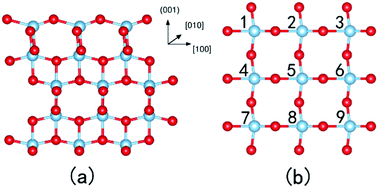Structure and reactivity of a water-covered anatase TiO2(001) surface†
Abstract
We systematically studied water adsorption and oxidation on the unreconstructed TiO2(001) surface using first-principles calculations. Water first adsorbs on the surface in a dissociative state and then in a molecular state, as water coverage increases. The geometric properties of all adsorption structures suggest that the dissociative water molecules can induce stress release of the (001) surface at low coverage, reducing reactivity of the surface and thus leading to molecular adsorption of water on the surface at high coverage. The adsorption energy (or the surface energy) monotonously increases (or decreases) with the increase of the coverage, which further confirms that water, irrespective of its dissociative or molecular state, can improve the stability of the (001) surface and reduce its activity. We deeply investigated the mechanism of the oxygen evolution reaction (OER) on the water-covered (001) surface. A new water-assisted OER pathway is identified on the (001) surface, which includes the sequential transfer of protons from molecular water and surface hydroxyls, and O–O coupling processes. During the OER pathway, the O–O coupling step exhibits the largest thermodynamic energy and highest energy barrier, clarifying that it is the rate-determining step in the whole pathway. Our findings provide new insights into the strong dependence of water adsorption modes on coverage for the anatase TiO2(001) surface and may explain the high oxidation activity of the TiO2(001) surface in aqueous environments typical of TiO2 photocatalysis.



 Please wait while we load your content...
Please wait while we load your content...